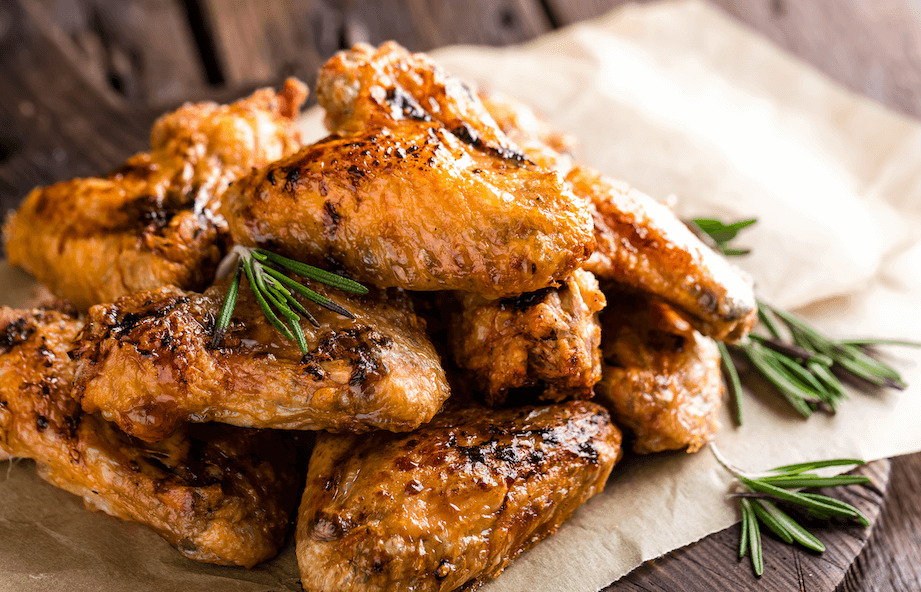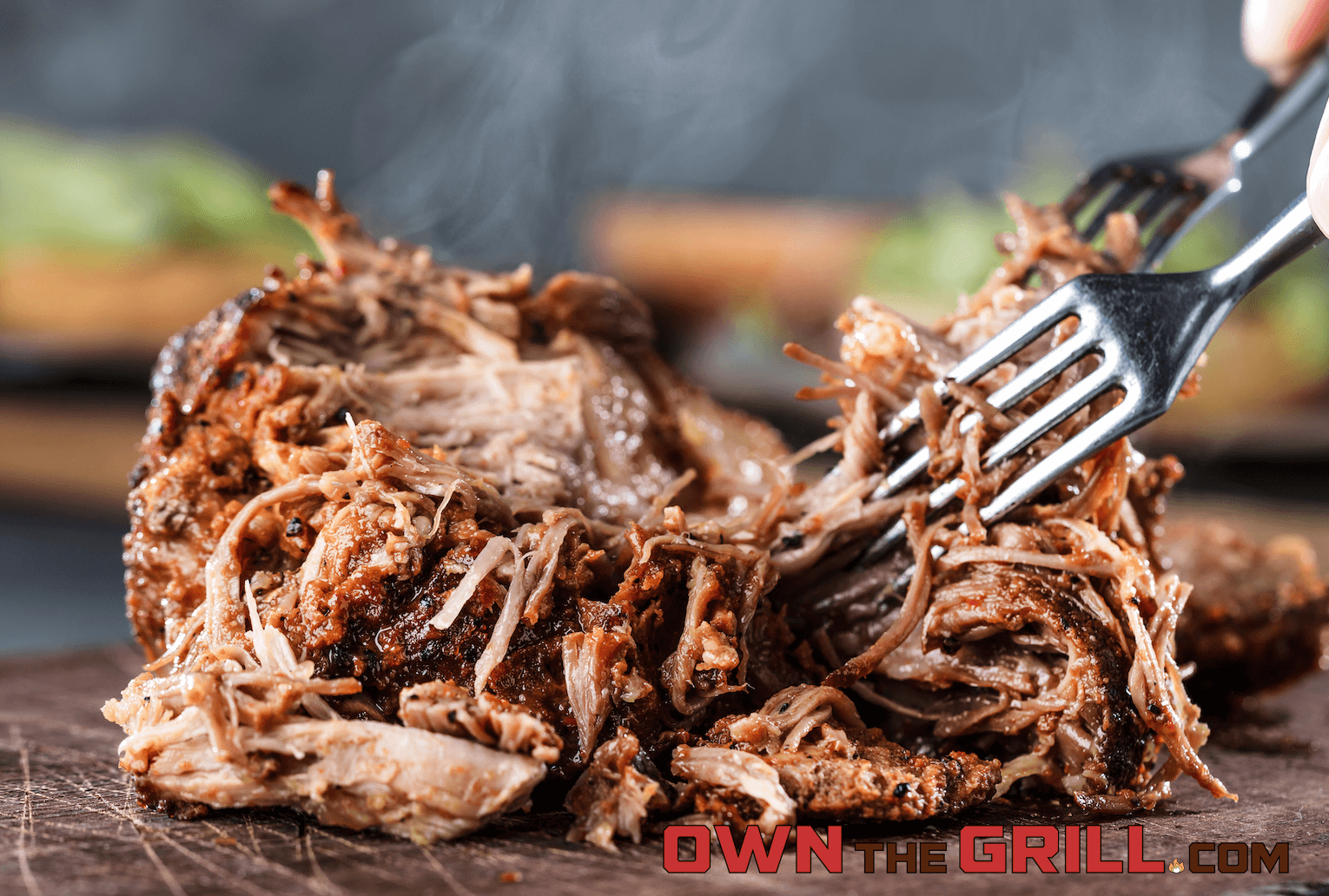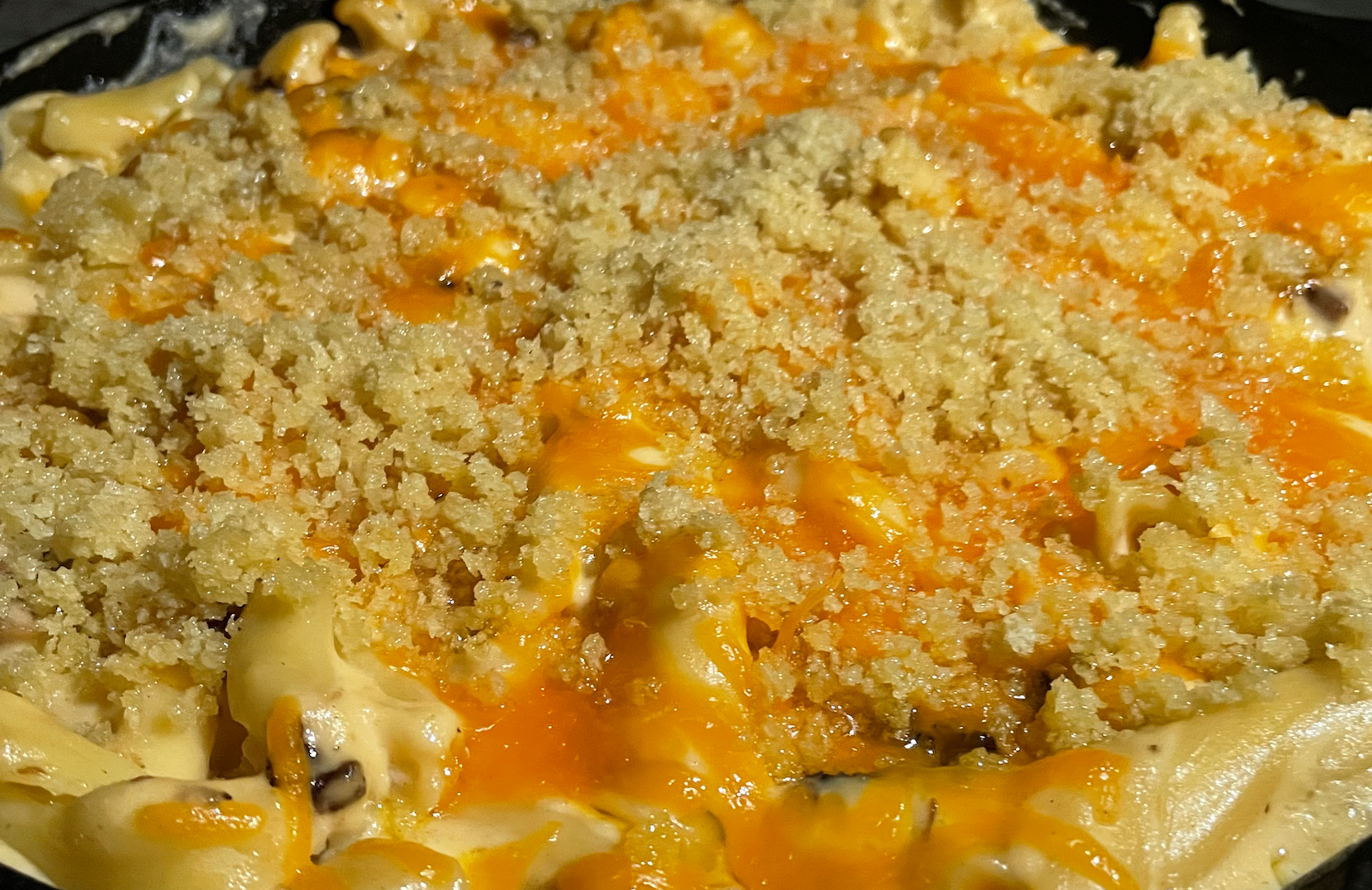You’ve spent all day smoking the perfect pork butt for a delicious meal, and now there are a ton of leftovers. The last thing you want to do is let all of that hard work and good food go to waste!
To get the most out of your pulled pork, you have to know how to store it well and the best methods for reheating.
There are some other practical reasons to reheat pulled pork too. Maybe you have a big gathering of family and friends coming over the next day around noon to watch the game. You definitely wouldn’t have the time to smoke pulled pork and serve it all in that morning.
In that case you’d want to cook it a day or two early, store it properly, then reheat to serve your guests.
In this post, we’ll go over everything you need to know about reheating pulled pork. We’ll go over how to use various methods, how to store your food properly, and some great recipes you can use to serve delicious reheated pulled pork.
Get Started the Right Way With Proper Storage
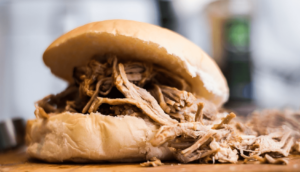
To get the most out of pork, the work actually begins right after you finish cooking or smoking your pork. In order to keep your pulled pork juicy and tasty, you’ll need to store it properly.
If you’re cooking a pork for the following day, it’s actually better to keep the pork butt whole. Wrap it in foil and put it in your refrigerator. By keeping it whole, it will retain moisture much better compared to shredding and then storing it.
If you’ve already pulled your pork and have a bunch left over, that’s ok! After you finish cooking and pulling your pork, just be sure to save the pan drippings and juices that come out. You’ll want to keep these for later to help your food stay moist and juicy when you reheat.
Put your pulled pork in a container, then combine with the pan drippings and juices. From there, you can put your leftovers in the fridge or freezer for storage.
You’ll want to do this step as soon as possible. The USDA explicitly advises against leaving food out too long at room temperature. If your food remains between 40°F and 140°F for too long, there’s an increased risk of bacteria growing to dangerous levels.
- Dishwasher, microwave, and freezer safe
- Large containers are perfect for brisket, pulled pork, or other BBQ leftovers
- Stackable for easy organization
5 Different Ways to Reheat Pulled Pork
Reheating Pulled Pork in the Microwave
The first and easiest method for reheating pulled pork is to do it in the microwave. This is personally my least favorite way to reheat pulled pork, but it’s a simple and effective way to do it. It’s especially good if you’re short on time.
To use this method, you’ll first need to make sure that your pork is in a microwave safe container. It’s vital that you don’t microwave any plastic wrappings that aren’t microwave safe. These can lead to harmful chemicals and toxins getting cooked into your food.
Here’s a step by step guide for how to reheat pulled pork in the microwave:
- Step 1 – Gather your pulled pork and place it into a microwave container.
- Step 2 – If you stored your juices and drippings in a separate container, pour a proportionate amount over the pork you want to be reheated.
- Step 3 – Place your pulled pork and drippings in the microwave, cover the container, and cook on the medium setting for a minute at a time. After each minute, check the temperature of your pork so you don’t overcook it. Ideally you should check it with a thermometer. Your food is ready to go once it reaches a temperature of 165°F.
- Step 4 – If your food is drying out, add an extra splash of juices and pan drippings. If you run out or forgot to save the drippings, you can substitute a splash of apple juice or BBQ sauce instead. The pan drippings are ideal though.
- Step 5 – Ready to serve!
Reheating Pulled Pork in the Oven
If you have a little more time on your hands, using your oven as a means of reheating is healthier and is a great way to warm up a particularly large portion of pulled pork.
- Step 1 – Preheat your oven to 225°F
- Step 2 – Take your whole pork butt or shredded pork in an oven safe dish. Add pan drippings as needed. Just a little splash should be sufficient if you’re reheating a whole butt, but you might want to use extra or all of your leftover drippings if you’re reheating pulled pork. Apple juice, broth, and BBQ sauce are good replacements for drippings if you run out or forgot to save them.
- Step 3 – Cover your meat with foil. The layer of foil will help to retain and lock in moisture while your foil reheats. Set your dish on the middle rack of your oven that is now heated to 225°F.
- Step 4 – Heat your leftover pork in the oven until it reaches an internal temperature of 165°F. It’s easiest to measure your food’s temperature with the aid of a probe meat thermometer. Just to give you an idea, this could take 30 minutes to an hour depending on how much food you need to reheat.
- Step 5 – Pro tip* after your pork reaches 165 degrees, open the foil at the top to expose the top layer of your pork. Leave it in the oven for just a few minutes longer to add a little bit of delicious bark to your food.
- Step 6 – If you started this process with a full pork butt, now is the time to shred it. Serve and enjoy!
That’s how to reheat pulled pork in the oven! This method is healthy and ideal if you have the time.
Reheating Pulled Pork on the Grill
In order to reheat the best on a grill, you’re going to use indirect heat grilling to reheat pulled pork. The reason is, you don’t want the direct heat of your flame to easily dry out your food.
For those not familiar, indirect heat means setting up 2 zones on your grill. The heated portion of your grill is to the side of where your food sits while it cooks. Not directly under it. You’re trying to create an environment using convection heat inside of your grill that’s not all that different from cooking in an oven.
You might be wondering why you’d do indirect heating on a grill instead of just using an oven. After all, it’s probably a little extra work to do it on the grill.
There are a few small practical reasons, but the main answer is flavor. Using your grill allows you to impart another small round of flavor add into your food, especially if you’re reheating with a charcoal or wood fired grill.
- Step 1 – Create your two zone cooking on your grill. On a gas grill, that means turning one side of your grill’s burners on while leaving the other side off. For charcoal grills, place your coals in a pile on only one side of your grill.
- Step 2 – Heat your grill until the indirect side (the side where the flames are NOT active) reaches 225°F.
- Step 3 – Take your meat out of the refrigerator and wrap it in two layers of foil. Add your pan drippings to the meat before you completely wrap in foil. For whole butts, it’s probably worth adding an extra quarter of a cup of water or broth to ensure the meat remains moist enough.
- Step 4 – Place the foil wrapped meat on the indirect side of the grill. Leave it on the grill until it reaches an internal temperature of 165°F. Again, a probe meat thermometer helps a lot for this!
- Step 5 – Take your meat off of the grill after it reaches temperature and unwrap the foil. Be sure to save and keep all of the drippings.
- Step 6 – If you want to crisp the outside of your pork for a barky outside, place it on the direct heat side of the grill for a couple of minutes. If your meat is already shredded, put it in a grill safe aluminum pan for this part.
- Step 7 – Remove from the grill, shred your pork if needed, then serve and enjoy!
Reheating pulled pork on the grill is probably my favorite way of doing this, but it does require a tiny bit of extra effort, coordination, and time!
Reheating Pulled Pork in a Crock Pot
Crock pots and slow cookers are great set it and forget it methods of reheating pulled pork.
- Step 1 – Set your crock pot to either the low heat or keep warm setting.
- Step 2 – Add your meat to the crock pot along with pan drippings or a splash of apple juice and/or BBQ sauce. Be careful not to over do this step with a crock pot though. Slow cookers do a really good job of retaining moisture so you we’re less concerned about this method resulting in dry meat.
- Step 3 – Keep your food inside the pot until it reaches a temperature of 165°F. This typically takes around 2-3 hours on the keep warm or low setting of most crock pots.
- Step 4 – Ready to serve!
The Sous Vide Method
Sous Vide just sounds fancy, but it’s really a fairly simple method of cooking and heating food. You just need a couple of pieces of equipment to get it done.
The Sous Vide method implies vacuum sealing your food in a bag then placing said vacuum sealed bag into hot water.
Obviously, that means you’ll need to have a vacuum sealer machine on hand.
- Step 1 – Bring your Sous Vide machine or pot of water up to 165°F or a little bit hotter if you need to move quicker.
- Step 2 – Place your vacuum sealed bags of pork into the water.
- Step 3 – Keep your food inside the water until it reaches a temperature of 165°F. The rule of thumb is about 30 minutes per inch of thickness of your bag.
- Step 4 – Ready to serve!
The great thing about the Sous Vide method is that you don’t need to worry much about adding drippings or additional moisture thanks to the sealed bag.
How Many Times Can You Reheat Pulled Pork?
The technical answer to this question is up for debate. For practicality’s sake, it’s probably best to plan on reheating pulled pork only one time, maximum.
Each time you reheat pulled pork, it will spend quite a bit of time in that 40°F to 140°F range where it’s prone to bacteria growth. We obviously don’t want that.
The other reason is that each time you reheat food, it takes away moisture and also takes away from the quality and taste of your food. Especially if you’re using one of the quick methods outlined above like microwave reheating.
With that in mind, it’s probably best to plan on reheating just once. If you want your pork to last a longer time, freeze it in single serving portions so you don’t have to reheat an entire batch just to feed one person.
4 Quick and Easy Reheated Pulled Pork Recipes
You might also be wondering what exactly to do with all of that reheated pulled pork. If you did a good job of smoking it in the first place, it will be delicious on its own or with a little bit of BBQ sauce.
But if you really want to take it to the next level, here is a look at a few of our favorite leftover pulled pork recipes:
Pulled Pork Cuban Sandwich
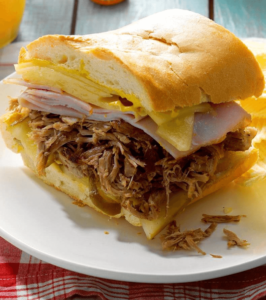
I’m as guilty as anybody of just slapping some meat in between bread and calling it a sandwich when I’m feeling lazy.
But you can take the flavor of your reheated pulled pork to the next level with this Pulled Pork Cuban Sandwich Recipe. It’s easy, quick, and doesn’t require a ton of ingredients.
Ingredients:
- 1 sub roll or baguette (12 inches give or take, depending on your preference)
- Yellow mustard
- 2 thick slices of Swiss cheese
- 2 thick slices of ham
- Dill pickle chips (about 8)
- Thinly sliced red onion (about 1/2 cup)
Slice the sub roll in half. If desired, toast the roll. Next, smear both sides of the roll with mustard. After that, place Swiss cheese, ham, leftover pulled pork, pickles, and onions.
Nachos
Nachos are the quintessential leftover meal. Pulled pork is the PERFECT meat to use in any delicious nachos recipe. With a few extra ingredients, you can be enjoying restaurant level nachos at home by utilizing your leftovers.
Ingredients:
- 12 oz tortilla chips
- 2 lbs. cheese (Mexican blend or combination of cheddar and Monterey jack)
- 1 diced avocado
- 1 cup refried beans
- 1/2 cup sour cream
- 1/4 cup sliced red onion
- 1/4 cup BBQ sauce (sweet)
- 1/4 cup sliced jalapenos (optional)
- Cilantro to garnish
- Lime to garnish
Heat oven to 350°F and cover a baking sheet with nonstick spray. Layer half of the chips on the sheet, and top with pulled pork, black beans, jalapenos, onions and cheese. Place another layer of chips, pulled pork, black beans, jalapenos, onions and cheese on top of that.
Bake 20-25 minutes or until cheese has melted. Remove from oven and add sour cream, avocado, BBQ sauce, cilantro and lime.
Pulled Pork BBQ Pizza
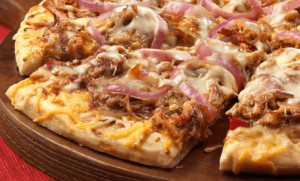
BBQ pizza is one of my all time favorites. It’s commonly served with chicken as the main meat, but pulled pork is just as delicious on a pizza, if not better.
You can make your own crust at home if that’s your thing, or you can buy and easy make crust from your local grocery store to get started.
Ingredients:
- 1 pizza crust (12 inches)
- 2 cups shredded cheese (Monterey jack or pizza blend ideal)
- 1 cup sweet and/or spicy BBQ sauce
- 1 cup sliced pepperoncini peppers
- 1 cup chopped red onion
- Leftover pulled pork
- 1/2 cup chopped cilantro
Preheat oven to 350°F. Place pizza crust on a baking sheet. Spread the BBQ sauce on the crust. Layer on cheese, pulled pork, peppers, onions, and cilantro. Bake in the oven for 15 minutes or until cheese is melted and crust is crispy.
Pulled Pork Mac and Cheese
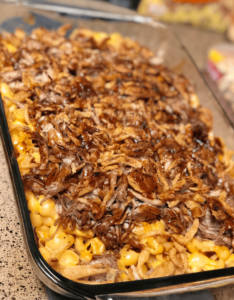
Mac and cheese – the ultimate comfort food. Pulled pork and mac and cheese go incredibly well together, and it’s a perfect way to utilize your reheated pulled pork.
You can make this one as simple or as sophisticated as you want. Personally I like just making boxed mac and cheese from the grocery per box instructions then topping with reheated pulled pork.
If you’re in the mood for something a little more sophisticated, grab the following ingredients:
Ingredients:
- Leftover pulled pork
- 1 pound elbow macaroni
- 2 tablespoons unsalted butter
- 2 tablespoons flour
- 2 cups whole milk, warmed
- 4 cups shredded sharp cheddar cheese
You can check out this great recipe here, just skip the part where they outline how to make the pulled pork.
Wrap Up
I hope this guide to reheating pulled pork has been helpful to you! Pulled pork is one of my absolute favorites, and there’s absolutely no reason you shouldn’t be able to enjoy delicious reheated pulled pork for another meal. If you’re ever wondering how much pulled pork you need per person, check out our guide and calculator here.
Knowing how to do this takes the pressure off! Now you can buy that big ol’ pork butt and know you’re going to get the most out of it. Nothing has to go to waste after it’s gone on the smoker.
Have any questions or know of any other recipes we should try out? Let us know in the comments section below. We also have plenty of more food knowledge (including how to reheat other types of foods the proper way).
Discover more from Own The Grill
Subscribe to get the latest posts sent to your email.



